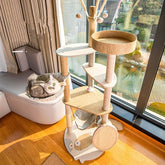Understanding the Costs and Benefits of Ultrasound for Cats: A Comprehensive Guide
Table of Contents
- Key Highlights
- Introduction
- The Role of Ultrasound in Feline Health
- Factors Influencing the Cost of Cat Ultrasounds
- Common Misconceptions About Cat Ultrasounds
- Preparing Your Cat for an Ultrasound
- FAQ
- Conclusion
Key Highlights
- Ultrasound is a non-invasive diagnostic tool that helps veterinarians visualize a cat's internal organs, aiding in the diagnosis of various health issues.
- The cost of an ultrasound for cats typically ranges from $200 to $800, influenced by factors such as location, veterinary clinic, and additional tests.
- Ultrasounds are considered safe for cats, with minimal risks involved, making them a vital part of feline healthcare.
Introduction
As pet owners, the health and well-being of our feline companions are paramount. When faced with unexplained changes in behavior or health, the need for diagnostic tools becomes crucial. One such tool is ultrasound, a non-invasive procedure that allows veterinarians to examine the internal workings of a cat's body. Understanding the nuances of cat ultrasounds, including their purpose, costs, and preparation requirements, can empower pet owners to make informed decisions regarding their pets' health.
Ultrasounds have gained prominence in veterinary medicine for their ability to provide clear images of the abdomen, heart, and other internal structures without the need for invasive surgery. This technology serves as an invaluable resource in diagnosing conditions ranging from gastrointestinal disorders to organ dysfunctions.
In this article, we will explore the intricacies of cat ultrasounds, including the costs involved, common misconceptions, preparation tips, and answers to frequently asked questions that may arise for concerned pet owners.
The Role of Ultrasound in Feline Health
Ultrasound technology operates on a simple principle: it uses sound waves to create images of the internal organs. This procedure is particularly beneficial for diagnosing a variety of conditions. For instance, if a cat is experiencing persistent vomiting or lethargy, an ultrasound may reveal underlying issues such as foreign object ingestion or organ diseases that may not be visible through other diagnostic methods.
Common Symptoms Indicating the Need for an Ultrasound
Pet owners should be vigilant for specific symptoms that may necessitate an ultrasound examination for their cats. Some of these signs include:
- Persistent vomiting or diarrhea: These gastrointestinal symptoms could indicate serious health issues.
- Lethargy or weakness: A marked decrease in energy may point to underlying medical conditions.
- Abdominal swelling or pain: This could signal fluid accumulation or organ enlargement.
- Changes in appetite or weight loss: Significant changes could reflect various health problems, from metabolic disorders to cancers.
Identifying these symptoms early can lead to timely diagnostics and treatment, ultimately improving the prognosis for the affected cat.
Factors Influencing the Cost of Cat Ultrasounds
When contemplating an ultrasound for a cat, the primary concern often revolves around cost. Ultrasound prices can vary significantly based on several factors:
Location
The geographical location of the veterinary clinic plays a significant role in pricing. Urban areas with higher living costs may charge more than clinics situated in rural regions.
Type of Veterinary Clinic
General veterinary practices may offer different pricing compared to specialized veterinary clinics that focus on imaging or specific conditions. The average cost for a cat ultrasound can range from $200 to $800, depending on the clinic's resources and expertise.
Additional Tests
In many cases, additional tests may be required alongside the ultrasound to provide a comprehensive assessment. These can include blood work or biopsies, which can add $50 to $200 to the overall cost.
Specialist Consultation
If a specialist is required for a more in-depth analysis, this can incur additional fees ranging from $100 to $300.
Understanding these factors can help pet owners budget accordingly and explore various options available for their pet's healthcare needs.
Common Misconceptions About Cat Ultrasounds
Despite their growing acceptance, several misconceptions about cat ultrasounds persist among pet owners:
"Ultrasounds Are Too Expensive"
While it's true that ultrasounds can represent a significant expense in veterinary care, many pet owners may not be aware that there are payment plans or financing options available through veterinary clinics. Additionally, the cost should be viewed as an investment in the cat's long-term health.
"Only Serious Conditions Require Ultrasounds"
Another misconception is that ultrasounds are only necessary for severe health issues. In reality, they can be instrumental in diagnosing a variety of conditions, even those that might seem minor at first glance. Early detection often leads to better outcomes.
"Sedation is Always Required"
Many pet owners fear that their cats will need sedation for an ultrasound. However, most cats do not require sedation and can remain calm during the procedure with appropriate handling by the veterinary staff.
Preparing Your Cat for an Ultrasound
Proper preparation is key to ensuring accurate imaging results during an ultrasound. Here are some essential tips for pet owners:
Fasting Instructions
Veterinarians typically recommend fasting cats for 8-12 hours before the ultrasound. This ensures that the stomach and intestines are clear, allowing for better visualization of internal organs.
Creating a Calm Environment
Stress can affect a cat's behavior, making it more challenging to perform the ultrasound. Ensure that the cat is calm and comfortable before the appointment. Consider bringing a familiar blanket or toy to help soothe them during the visit.
Following Veterinary Guidance
It's crucial for pet owners to follow any specific instructions provided by the veterinarian. This may include additional preparations based on the specific health concerns being investigated.
FAQ
How long does an ultrasound for a cat take?
An ultrasound typically lasts between 30 to 60 minutes, depending on the complexity of the case and the area being examined.
Can my cat eat before an ultrasound?
It is generally recommended to fast your cat for 8-12 hours before the procedure to ensure optimal imaging results.
Is sedation necessary for a cat ultrasound?
Most cats do not require sedation, as they can remain calm during the procedure with gentle handling.
Are there any risks associated with cat ultrasounds?
Ultrasounds are considered safe, as they do not involve radiation or anesthesia, which reduces the associated risks significantly.
What happens if abnormalities are found during the ultrasound?
If the ultrasound reveals any abnormalities, the veterinarian may recommend further testing or treatments to address the underlying issues.
How can I prepare my cat for an ultrasound appointment?
To prepare your cat, ensure they are calm and comfortable, and adhere to any fasting instructions provided by your veterinarian.
What should I discuss with my veterinarian before the ultrasound?
It's essential to discuss the potential costs, payment options, and any questions or concerns you may have regarding the procedure and its implications for your cat’s health.
Conclusion
Ultrasound technology has become a cornerstone of veterinary diagnostics, offering invaluable insights into the health of our feline friends. By understanding the costs, purposes, and preparation involved in an ultrasound, pet owners can approach this vital procedure with confidence.
As we continue to prioritize the health of our pets, being informed about these diagnostic tools ensures that we make the best choices for our beloved companions, paving the way for timely interventions and improved quality of life.





